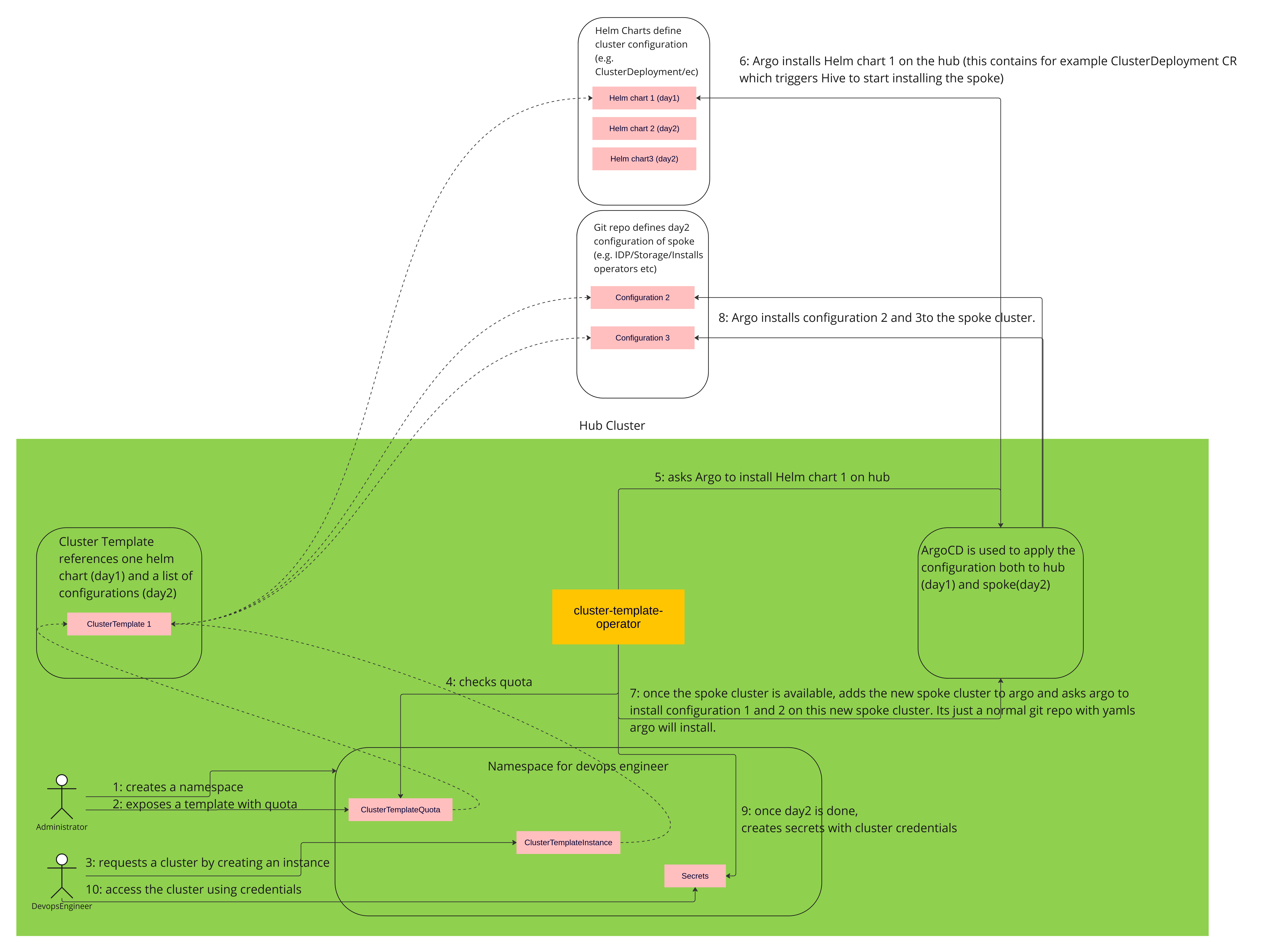Cluster as a service operator (CaaS)
Self-service clusters with guardrails. CaaS operator provides an easy way to define clusters as templates and allows non-privileged developers or DevOps engineers to create instances of those templates.
Features
- Deploys fully provisioned clusters: Gives your users a cluster they can immediately start being productive with, rather than an empty cluster
- Gitops driven: All configurations are applied using ArgoCD
- Integrated with ACM: If the CaaS is on an ACM hub cluster, all the ACM management features will work seamlessly with the cluster installed using CaaS.
- Adds additional guardrails: On top of classic k8s quotas, CaaS adds additional cost and count-based quotas, as well as the lifetime of your clusters
- Parameterizable: You can decide to let some of the aspects of the template be parameterizable.
- Requires minimal permissions: No oc get pods nor oc get secrets. Just one namespace, oc create ClusterTemplateInstance, oc get ClusterTemplate, oc get ClusterTemplateQuota, and oc get secret – all in one namespace. Nothing else.
How it works
How to install
Prerequisites
- Kubernetes cluster to run against.
- Hypershift or Hive operator for cluster installation.
The easiest option is to use an OCP cluster with Multicluster Engine (MCE) installed on it. This way you will get all the dependencies already prepared and configured.
Installation
On OCP cluster
Install the Cluster as a service operator from the OperatorHub:
- Go to OCP console
- Pick
local-clusterin the to left corner - In the menu select Operators -> OperatorHub
- Search for
Cluster as a service operator - Select it and hit install button
Note that ArgoCD is installed as dependency of the operator.
Non OCP cluster
Please follow the instructions from the OperatorHub page (https://operatorhub.io/operator/cluster-aas-operator).
ArgoCD configuration
As noted above ArgoCD is installed as a depency of the cluster as a service operator, but it's not configured to be used with the operator. Please follow ArgoCD configuration to setup ArgoCD.
How to use
Cluster as a service operator comes with a few ready-to-be-used templates.
Hypershift cluster without workers (not for production)
This template is not meant to be used in production. You can not run any workload on it nor can you ever scale it up. This template is only to be used to play with the CaaS and to understand its concepts.
Prerequisites
Hypershift enabled and configured on your cluster:
- If you have OCP + Multicluster Engine (MCE) installed on your cluster, follow these steps
- If you don't use OCP + Multicluster Engine (MCE), follow these steps
Steps
- Create a namespace “clusters” to store your clusters in
kind: Namespace
apiVersion: v1
metadata:
name: clusters
labels:
argocd.argoproj.io/managed-by: argocd- Create 2 secrets - one which contains the pull-secret and another one for the ssh public key
kind: Secret
apiVersion: v1
metadata:
name: pullsecret-cluster
namespace: clusters
stringData:
.dockerconfigjson: '<your_pull_secret>'
type: kubernetes.io/dockerconfigjson
---
apiVersion: v1
kind: Secret
metadata:
name: sshkey-cluster
namespace: clusters
stringData:
id_rsa.pub: <your_public_ssh_key>
- Allow to create the template in this namespace
apiVersion: clustertemplate.openshift.io/v1alpha1
kind: ClusterTemplateQuota
metadata:
name: quota
namespace: clusters
spec:
allowedTemplates:
- name: hypershift-cluster- Create an instance of the hypershift template by creating the following yaml
apiVersion: clustertemplate.openshift.io/v1alpha1
kind: ClusterTemplateInstance
metadata:
name: hsclsempty
namespace: clusters
spec:
clusterTemplateRef: hypershift-clusterCheck the cluster
Wait for the cluster to be ready. (please note the cluster will never actually import because it does not have any workers)
oc get ClusterTemplateInstance hsclsempty -n clusters- When the “status.phase” is “Ready”, you can log into the cluster
- The credentials are exposed as secrets and referenced from the status (kubeconfig, adminPassword, apiServerURL)
Hypershift cluster with kubevirt virtual machine workers
This will deploy an entirely self-contained cluster, meaning that both the control plane and workers will be running on the hub cluster. The control plane will be using hypershift and the workers will be running as virtual machines using kubevirt.
Prerequisites
Hypershift enabled and configured on your cluster:
- If you have OCP + Multicluster Engine (MCE) installed on your cluster, follow these steps
- If you don't use OCP + Multicluster Engine (MCE), follow these steps
Kubevirt enabled and configured on your cluster:
- If you have OCP installed on your cluster, install OpenShift Virtualization from OperatorHub in your cluster
- If you don't use OCP, follow the instructions in “install” part of operatorhub.io
Steps
- Create a namespace “clusters” to store your clusters in
kind: Namespace
apiVersion: v1
metadata:
name: clusters
labels:
argocd.argoproj.io/managed-by: argocd- Create 2 secrets - one which contains the pull-secret and another one for the ssh public key
kind: Secret
apiVersion: v1
metadata:
name: pullsecret-cluster
namespace: clusters
stringData:
.dockerconfigjson: '<your_pull_secret>'
type: kubernetes.io/dockerconfigjson
---
apiVersion: v1
kind: Secret
metadata:
name: sshkey-cluster
namespace: clusters
stringData:
id_rsa.pub: <your_public_ssh_key>
- Allow to create the template in this namespace
apiVersion: clustertemplate.openshift.io/v1alpha1
kind: ClusterTemplateQuota
metadata:
name: quota
namespace: clusters
spec:
allowedTemplates:
- name: hypershift-kubevirt-cluster- Create an instance of the hypershift template by creating the following yaml
apiVersion: clustertemplate.openshift.io/v1alpha1
kind: ClusterTemplateInstance
metadata:
name: hsclskubevirt
namespace: clusters
spec:
clusterTemplateRef: hypershift-kubevirt-clusterCheck the cluster
Wait for the cluster to be ready.
oc get ClusterTemplateInstance hsclsempty -n clusters- When the “status.phase” is “Ready”, you can log into the cluster
- The credentials are exposed as secrets and referenced from the status (kubeconfig, adminPassword, apiServerURL)
Documentation
Learn about CRDs
Permissions and env setup
License
Copyright 2022.
Licensed under the Apache License, Version 2.0 (the "License"); you may not use this file except in compliance with the License. You may obtain a copy of the License at
http://www.apache.org/licenses/LICENSE-2.0
Unless required by applicable law or agreed to in writing, software distributed under the License is distributed on an "AS IS" BASIS, WITHOUT WARRANTIES OR CONDITIONS OF ANY KIND, either express or implied. See the License for the specific language governing permissions and limitations under the License.
